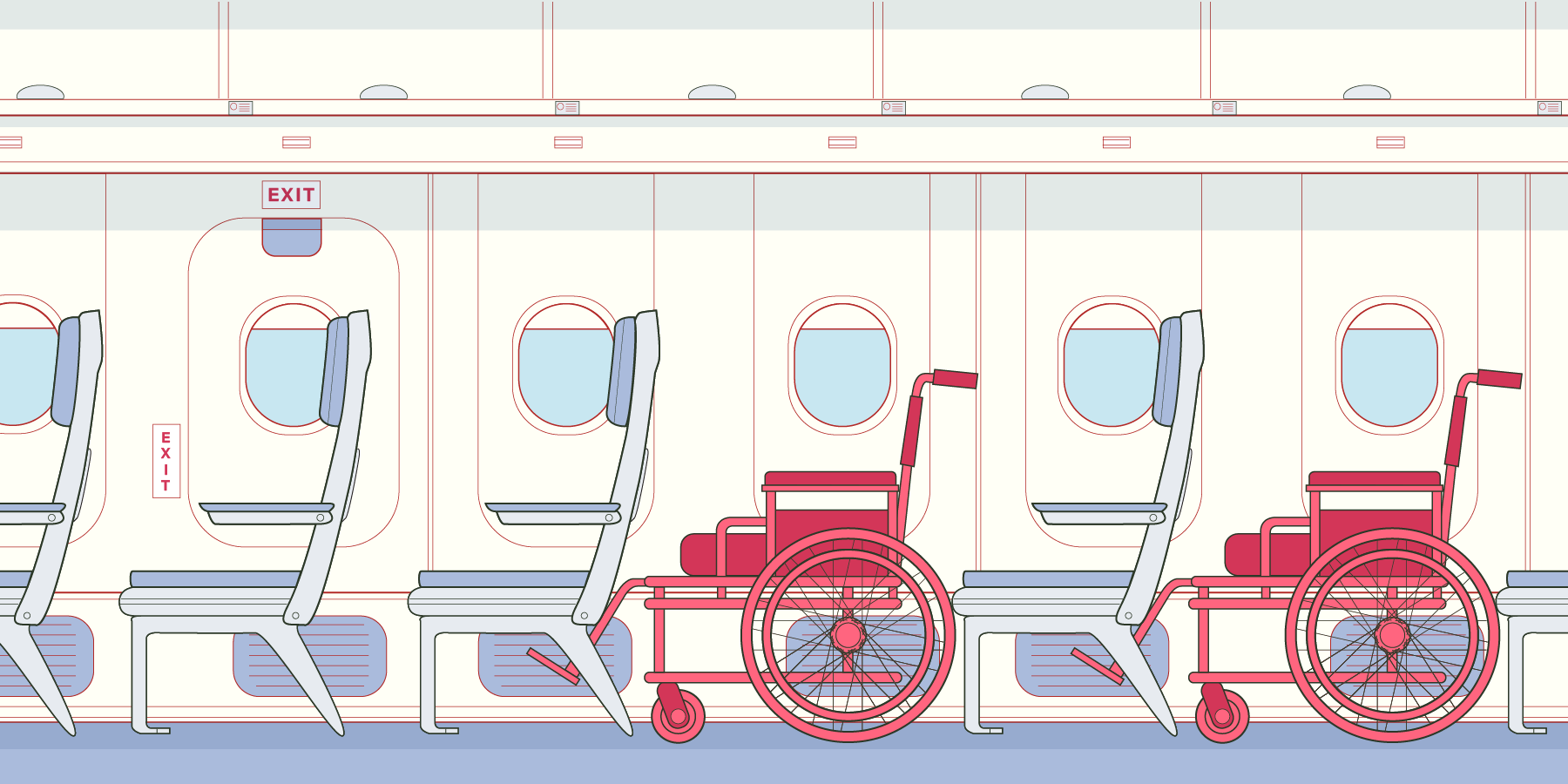

“That is your legs gone. It is a basic human right,” explained BBC journalist Frank Gardner in March, 2018, as he recounted being left on a plane for more than an hour and a half after landing, because Heathrow Airport staff could not find his wheelchair.
Months later, a video of paralympic athlete Justin Levene dragging himself through London Luton Airport went viral. Levene was suing the airport over the August, 2017, incident, which occurred when his custom-made wheelchair didn’t make it onto his flight. Upon landing, he was provided with a wheelchair that he couldn’t self-propel. Levene said that this did not allow him to retain his customary independence.
These are just two of the many news stories about wheelchair-using air passengers. I could fill many columns about damaged or lost wheelchairs, flights missed due to tardy assistance, and passengers who were medically cleared to fly but whom airlines barred from flights. But what do these airline protocols, which are supposed to serve passengers with disabilities, say about how those of us with disabilities are seen by our culture?
In 2009, while traveling with my husband in the southwestern United States, I dislocated my right kneecap. Though disabled since birth, I had not yet needed to use a wheelchair. A cane and my specially molded orthopedic shoes were enough to facilitate my getting around. Previously, I had used an airport wheelchair only to make travel easier. Now using a wheelchair was necessary.
Our first flight, from Colorado’s Grand Junction Regional Airport, was delayed for close to five hours due to mechanical reasons, and we knew that we would miss not only our connecting flight but also the last flight home. This meant that we would have to stay overnight in Denver. I informed the gate agent that I could not walk and would need a wheelchair not only at the airport but also at the hotel the airline would provide. The gate agent assured me that this would not be a problem.
But when we finally reached Denver, the United Airlines customer service desk told me that a wheelchair outside of the airport could not be provided. I was told that United was not liable because the first flight was managed by a subcontracted regional airline. When I pointed out how ridiculous this was, I was then told that United was not responsible for wheelchairs at the airport, and that the airport would not allow one of its wheelchairs to be taken off-site.
Thankfully, the airport employee who was assisting us pointed to an unattended airport wheelchair, nonverbally suggesting that we take it. We did. After figuring out how to use the wheelchair-inaccessible shuttle to the hotel, we encountered no further difficulties and returned home on the first flight the next morning.
What I learned in 2009, and from flying with my wheelchair ever since, is how at each stage of travel the responsibility for serving disabled passengers is passed down the line: from the reservation agent to the disability or medical services desk (if an airline has one), then to the check-in counter agent, then to the company contracted to assist disabled passengers, then on to the gate agent, the ground crew, and the flight crew. Once the plane lands, the staffers onboard pass the responsibility to this facility’s ground crew, and finally to yet another company that serves disabled passengers at the destination airport. (Air Canada is the only airline I know that, due to union regulations, uses its own employees to assist disabled passengers in airports. Often a single employee is dispatched to assist multiple wheelchair-using and/or elderly passengers.)
This chain of responsibility allows airline employees to pass the buck when something goes awry. Often, when the person who is supposed to assist in boarding doesn’t show up, the gate agent feebly says that there’s nothing to be done as they are not responsible for that service.
One example of passing the buck: en route from Shanghai to Berlin, we landed in Vienna for our connecting flight to find my wheelchair was missing its brakes. “It happened in China,” the lead agent for Austrian Airlines, who operated both flights of our journey, told me–literally distancing herself from what had transpired.
And, on a recent trip to Mexico, a delay with our first Lufthansa flight caused a very tight connection in Frankfurt. The situation was compounded when we waited an inordinate amount of time for my wheelchair to be brought to us. When it finally arrived, one of the brakes was damaged. Then, despite assurances from both the pilot and lead flight attendant that there would be someone to help us through the sprawling airport to make our connecting flight, nobody arrived to assist us.
The Air Carrier Access Act (ACAA) is the law ensuring the rights of passengers with disabilities on flights both departing and arriving at U.S. airports. The ACAA is enforced by the U.S. Department of Transportation. European flights are bound by E.U. regulation 1107/2006 of the European Parliament and by amendments to the regulation. These statutes state requirements but don’t dictate how services should be delivered. Clearly, the system needs to be rethought and redesigned, with the voices of disabled travelers in the lead.
After BBC journalist Gardner’s complaint at Heathrow Airport, The Independent reported that the U.K. Department for Transport (DfT) was “considering a raft of new measures to make flying a more enjoyable experience for disabled passengers and those with reduced mobility.” Gardner has commended Heathrow officials: “They have undertaken that by the summer they will bring wheelchairs up [to] the door of the plane as a matter of policy.” There is also hope for “an accredited nationwide accessibility training scheme” to “improve care for passengers needing special assistance.”
Though many disabled people would rather stay in their wheelchairs during a flight, according to The Independent the removal of seats to allow space for a wheelchair would not pass muster with security officials, because “existing seating on aircraft must meet rigorous standards on withstanding a survivable crash.” An unnamed airline executive said, “However strong the restraints are, the idea that any wheelchair could ever provide the same protection as a properly certified aircraft seat is far-fetched.”
There is no question that safety during air travel should be paramount. But being able to live independently as a disabled person has been a goal of the disability rights movement since the 1960s. (In 1972, the first independent living center to support this goal was opened in Berkeley, California.) Airlines and airports must prioritize independence when they create policies and systems for how they treat people with disabilities. Our travel should neither be informed by the whims of employees, nor by faulty systems that limit, or even remove, our agency.
The systems used to assist disabled passengers are different at each airport, as are the wheelchairs provided for those who don’t travel with their own–making air travel especially difficult to navigate for travelers who each have different needs. Though I certainly do not agree with Levene, the paralympian, that it is demeaning for someone to be pushed through the airport in a wheelchair, I cannot deny how he feels about his own body in relation to the world. The newer wheelchairs provided in many airports do not allow the user to self-propel, but do include a space below the seat for luggage transport. Surely someone who is familiar with universal design principles can design a wheelchair that serves both user and aide. As with most issues of access, one size does not fit all–but clear, and transparently applied, policies are a good place to begin.
When DfT announced its new initiative, Gardner described it as “a step in the right direction,” albeit one “years later than it should have been.” Meanwhile, I’m still waiting for a response from Lufthansa regarding my complaint about what transpired during my trip from Berlin to Mexico City.


How We Get To Next was a magazine that explored the future of science, technology, and culture from 2014 to 2019. This article is part of our “Disability” Beat, which asks the question: What will it take to include disability in our future debates about diversity? For more dispatches, click the logo.
